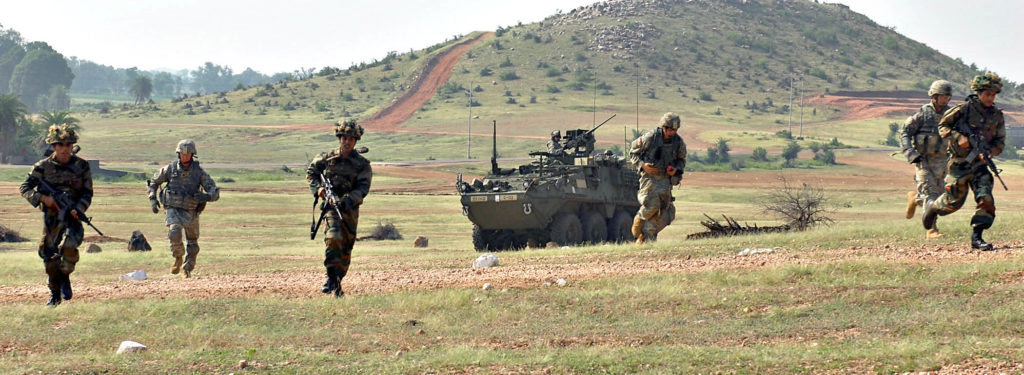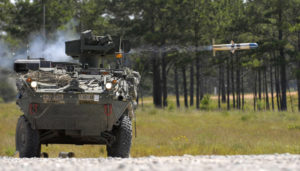The Stryker Land Vehicle
Since it was introduced in 2002 by General Dynamics Land Systems, the Stryker land vehicle has been one heck of a versatile machine. With ten configurations, this eight-wheeled, armored combat vehicle provides the U.S. Army with an effective mix of capabilities, including infantry transport, offensive firepower, and reconnaissance.
Roll the Stryker land vehicle onto C-130, C-17, or C-5 aircraft, and it can be deployed combat-ready to any contingency area around the globe. The Stryker land vehicle is designed for agile maneuvering in urban settings while providing protection in open terrain. Recent upgrades to add a double-V hull have vastly improved troop survivability against IEDs, the enemy weapon of choice in Afghanistan.
Unique Technology:
What really sets the Stryker family of combat vehicles apart from others is its versatility. Its ten configurations can be operated by a crew as small as two and can carry as many as nine infantry soldiers.

Relying on common parts between variants and other Army vehicles, the Stryker has maintained a superb 96% readiness rate throughout the ongoing conflicts in Afghanistan and the surrounding regions.
Power & Drivetrain:
The Stryker land vehicle is currently powered by a 350 horsepower Caterpillar JP-8 diesel engine. A commercial-off-the-shelf replacement engine is scheduled to boost performance by nearly 30% to a whopping 450 horsepower.

Hooked up to a 6-speed Allison transmission, this 8-wheel drive combat vehicle can handle any terrain. Not to mention, its four-wheel steering allows for exceptional maneuverability.
Cost:
Based on recent U.S. Army purchases, the Stryker land vehicle costs roughly $5.2 million. With 85% common parts across the 10 configurations, the Stryker is able to maintain low operating and life cycle costs.

Armament:
The standard weaponry is a remote weapon station equipped with either a .50 caliber or 7.62 mm M240 machine gun, or a MK19 grenade launcher.
For more firepower, the Stryker land vehicle can also carry two tube launched, optically-tracked, wire-guided (TOW) missile systems, a 120mm recoil mortar system, or a 105mm main gun, depending on its configuration.

Uses:
This vehicle can do just about anything. As mentioned before, there are a whopping 10 different configurations off the two base platforms (Infantry Carrier Vehicle and Mobile Gun System) giving Stryker Brigade Combat Teams a slew of capabilities.
These include anti-tank guided missiles, mobile C4ISR, engineering support, fire support (target ID, acquisition, and designation), 9-man infantry transport, medical evacuation, mobile gun system, mortar, NBC reconnaissance, and general reconnaissance capabilities.
Speed:
The Stryker can reach speeds of 60 mph — not bad for a 19-ton combat vehicle.

History & Development:
The Stryker entered service in 2002 and is named after two Medal of Honor recipients killed in World War II and Vietnam, respectively. There are currently more than 4,100 in service.
After performing exceptionally in Iraq’s urban terrain, the Stryker initially struggled in Afghanistan. Prone to devastating IED attacks, the vehicle was outfitted with a new double-V hull. The improved design led to staggering improvements in soldier survivability.
In 2012, Lt Gen Bill Phillips, then principal military deputy to the Assistant Secretary of the Army for Acquisition, Logistics and Technology, commented on the Stryker’s redesigned hull.
“To hear from the field, back from soldiers and commanders about the value of the double-V hull, it is truly remarkable. That vehicle has performed beyond our expectations in countering IEDs, and we will continue to field them.”
Seven of the 10 Stryker variants have been outfitted with the special hull design. Only the mobile gun system and two reconnaissance versions come solely with flat bottoms.
In October 2016, the first Stryker Infantry Carrier Vehicle prototype equipped with a 30mm cannon was delivered to the Army. This came in response to the discovery of increased Russian capabilities following their 2015 invasion of Ukraine.
See Stryker Land Vehicle Specifications
| Height: 122 – 137 in |
| Width: 116 – 153 in |
| Length: 286 – 299 in |
| Weight: 19 tons |
| Temperature Operating Range: -40 °C to +70 °C, |
| Deployability: C-130 – 1 each, C-17 – 3 each, C-5 – 4 each |
| Wheel Clearance: 21 in |
| Vertical Climb: 23 in |
| Gap Crossing: 76 – 78 in |
| Range: 300 – 330 mi |
| Winch: Self-Recovery |
| Top Speed: 60 mph |
| 50 Meter Dash: 9 sec |

